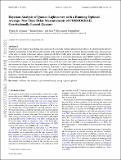Files in this item
Bayesian analysis of quasar lightcurves with a running optimal average : new time delay measurements of COSMOGRAIL gravitationally lensed quasars
Item metadata
| dc.contributor.author | Donnan, Fergus R. | |
| dc.contributor.author | Horne, Keith | |
| dc.contributor.author | Santisteban, Juan V. Hernández | |
| dc.date.accessioned | 2021-10-26T11:30:07Z | |
| dc.date.available | 2021-10-26T11:30:07Z | |
| dc.date.issued | 2021-12 | |
| dc.identifier | 276420568 | |
| dc.identifier | 5685849d-2487-42f6-9ae5-e3be133f0528 | |
| dc.identifier | 85119487718 | |
| dc.identifier | 000715897400047 | |
| dc.identifier.citation | Donnan , F R , Horne , K & Santisteban , J V H 2021 , ' Bayesian analysis of quasar lightcurves with a running optimal average : new time delay measurements of COSMOGRAIL gravitationally lensed quasars ' , Monthly Notices of the Royal Astronomical Society , vol. 508 , no. 4 , pp. 5449–5467 . https://doi.org/10.1093/mnras/stab2832 | en |
| dc.identifier.issn | 0035-8711 | |
| dc.identifier.other | ArXiv: http://arxiv.org/abs/2107.12318v2 | |
| dc.identifier.other | ORCID: /0000-0002-6733-5556/work/102330774 | |
| dc.identifier.uri | https://hdl.handle.net/10023/24192 | |
| dc.description | Funding: KH and JVHS acknowledge support from UK Science and Technology Facilities Council grant ST/R00824/1. | en |
| dc.description.abstract | We present a new method of modelling time-series data based on the running optimal average (ROA). By identifying the effective number of parameters for the ROA model, in terms of the shape and width of its window function and the times and accuracies of the data, we enable a Bayesian analysis, optimising the ROA width, along with other model parameters, by minimising the Bayesian Information Criterion (BIC) and sampling joint posterior parameter distributions using MCMC methods. For analysis of quasar lightcurves, our implementation of ROA modelling can measure time delays among lightcurves at different wavelengths or from different images of a lensed quasar and, in future work, be used to inter-calibrate lightcurve data from different telescopes and estimate the shape and thus the power-density spectrum of the lightcurve. Our noise model implements a robust treatment of outliers and error-bar adjustments to account for additional variance or poorly-quantified uncertainties. Tests with simulated data validate the parameter uncertainty estimates. We compare ROA delay measurements with results from cross-correlation and from JAVELIN, which models lightcurves with a prior on the power-density spectrum. We analyse published COSMOGRAIL lightcurves of multi-lensed quasar lightcurves and present the resulting measurements of the inter-image time delays and detection of microlensing effects. | |
| dc.format.extent | 7570377 | |
| dc.language.iso | eng | |
| dc.relation.ispartof | Monthly Notices of the Royal Astronomical Society | en |
| dc.subject | Methods: data analysis | en |
| dc.subject | Gravitational lensing: strong | en |
| dc.subject | Quasars: general | en |
| dc.subject | QB Astronomy | en |
| dc.subject | QC Physics | en |
| dc.subject | DAS | en |
| dc.subject.lcc | QB | en |
| dc.subject.lcc | QC | en |
| dc.title | Bayesian analysis of quasar lightcurves with a running optimal average : new time delay measurements of COSMOGRAIL gravitationally lensed quasars | en |
| dc.type | Journal article | en |
| dc.contributor.sponsor | Science & Technology Facilities Council | en |
| dc.contributor.institution | University of St Andrews. School of Physics and Astronomy | en |
| dc.contributor.institution | University of St Andrews. St Andrews Centre for Exoplanet Science | en |
| dc.identifier.doi | https://doi.org/10.1093/mnras/stab2832 | |
| dc.description.status | Peer reviewed | en |
| dc.identifier.grantnumber | ST/R00824/1 | en |
This item appears in the following Collection(s)
Items in the St Andrews Research Repository are protected by copyright, with all rights reserved, unless otherwise indicated.

